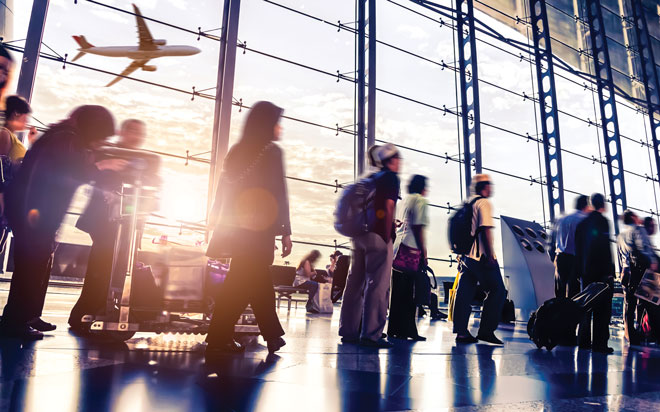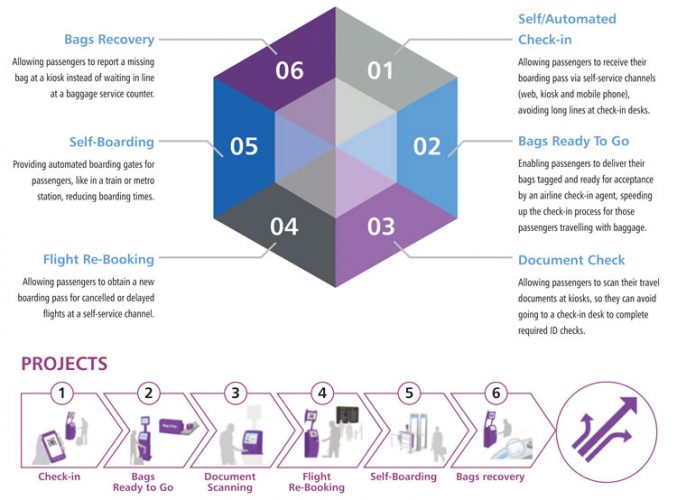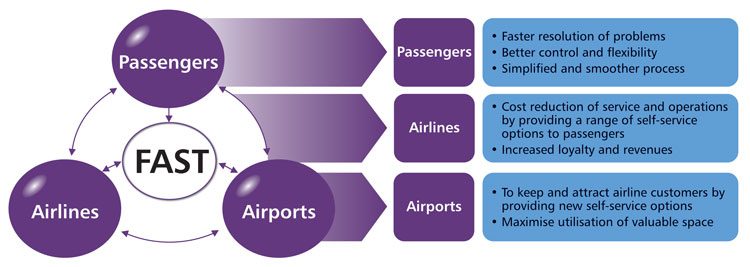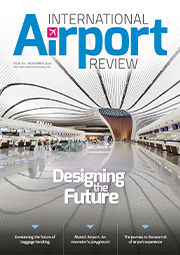Passenger Processing: The benefits of fast travel
- Like
- Digg
- Del
- Tumblr
- VKontakte
- Buffer
- Love This
- Odnoklassniki
- Meneame
- Blogger
- Amazon
- Yahoo Mail
- Gmail
- AOL
- Newsvine
- HackerNews
- Evernote
- MySpace
- Mail.ru
- Viadeo
- Line
- Comments
- Yummly
- SMS
- Viber
- Telegram
- Subscribe
- Skype
- Facebook Messenger
- Kakao
- LiveJournal
- Yammer
- Edgar
- Fintel
- Mix
- Instapaper
- Copy Link
Posted: 24 May 2016 | IATA | No comments yet
In 2007 IATA launched the ‘Fast Travel’ initiative to help airports around the world provide fast and hassle-free journeys to their passengers. In this article, IATA reviews the strengths of the initiative and considers how, in today’s digital world, airports can harness mobile technology to create seamless travel…


“The demand for air transport continues to grow. There is much work to be done to prepare for the seven billion passengers expected to take to the skies in 20341 ,” said Tony Tyler, IATA’s Director General and CEO when IATA released its updated passenger growth forecast in November 2015.
If you have travelled recently, you might have noticed that in several airports around the world passengers are standing in long queues to complete airport formalities. According to the 2015 IATA Global Passenger Survey, 90% of passengers want to be checked-in and know their seat from the comfort of their own home2. Other industry surveys indicate that over 50% of passengers worldwide want more self-service options to speed up their journey through airports3.
In essence, in today’s digital world passengers want to be in control of their journey and avoid long queues. They want such control not only for checking-in, but also at other airport process points. As a result, airports are facing increased pressure from both airlines and passengers to provide a seamless journey through their facilities. To meet customer demands, many airports have already recognised the need to address this change by providing flexible infrastructures; however, many more require information and guidance in delivering appropriate solutions.
Evidence from mature markets indicates that self-service is fast becoming the process of choice for passengers in many of the steps in the overall passenger process. It may be argued that these are the only options offered, but this has not proven to be the case. Passengers are offered a choice, nevertheless most choose self-service. For instance, in mature markets such as the United States many airlines are now experiencing 90% self-service penetration for check-in using a combination of delivery channels including automated check-in, kiosks, web and mobile.
However, this is only one part of the equation. The mobile technology revolution has made self-service options increasingly possible at every step of a passenger’s journey; from booking to boarding. For instance, in IATA’s Global Passenger Survey, approximately half of respondents stated that they prefer to tag/scan and put their bag(s) into the baggage system without agent intervention. They added that the acceptable drop-off time would be between one and three minutes4 . This is an initiative that both airlines and airports are heavily investing in as 74% of airports plan to implement assisted bag-drop kiosks by 2017 and 86% of airlines plan to do the same by 20175. Understanding what travellers want is the key to meeting their expectations and utilising new technology, not only to improve airport processes but to optimise facilities’ space allocation, is crucial to meet the expected increase in passenger flows for the coming years.
IATA’s Fast Travel Programme
Initiated in 2007, IATA’s Fast Travel initiative responds to passenger demands for a seamless travel experience and for control over their journey through time-saving, self-service options. The programme consists of six initiatives (Figure 1):


Figure 1: The six initiatives in IATA’s Fast Travel initiative Source: IATA Fast Travel Program
In IATA’s 2015 Global Passenger Survey 48% of air travellers had used an automated boarder control system and they had an 89% satisfaction rate with an automated immigration gate6. According to IATA, the programme vision is that by 2020 80% of global passengers will be offered with a complete, relevant self-service suite throughout their journey. The benefits of this initiative are three-fold, as depicted in Figure 2.


Figure 2: Benefits of the Fast Travel initiative
Source: IATA Fast Travel Program
In a recent interview Pierre Charbonneau, Director – Passenger for IATA, stated that: “IATA is very pleased to work in partnership with key stakeholders to continue this critical industry transformation programme which offers convenience, control and choice to passengers while allowing the airports to use their facilities more efficiently and provide customers with an improved overall travel experience… airlines can enhance the value proposition to their passengers and so realise enhanced customer service, reduce their cost base and improve their bottom line.”
Keeping passengers up-to-date
According to the results of the Expedia®/Egencia Mobile Index – a global study of mobile device-related behaviour and preferences among travellers – travellers now consider smartphones to be the single most indispensable item they carry with them when they travel, ahead of their toothbrush, deodorant and driver’s licence7. As a result most – if not all – aviation stakeholders interacting with passengers have already launched apps and other communication tools to stay in touch with their customers. However, smart technology is also changing the way we travel. For instance, last year JFK Airport started displaying real-time wait times for major queues. The screens are placed at TSA Security and Customs and Border Protection checkpoints, as well as the indoor taxi queue. The wait times are driven by sensors that monitor passengers’ mobile devices as they move through the airport. Gert-Jan de Graaff, President and CEO of JFK International Airport, stated at the launch of the service that “this new system will help us manage and eliminate problem spots within the facility, and sharing the processing time with our travellers will provide them with peace of mind so they may continue to expect a pleasant travel experience8”.
During his opening speech at the 2015 World Passenger Symposium, Mr. Tyler also stated: “As an industry, we need the ability to engage with our customers in real time via text message, email or social media; to update them on their flight status, gate changes, wait times at security and immigration, even what traffic is like to and from the airport. We also need to be able to communicate with other travel providers pro-actively so that, for example, car services and hotels are automatically informed when a customer is delayed or rerouted.”
He called this the concept of ‘travel communication’: “To get there we must move from a model of centrally-controlled, closely-guarded access to data, to a social media model of widely available, open and transparent communication of useful information. Social media already provides ways for large retailers to deliver personalised service. Travel communications will provide similarly cost-effective ways to engage and inform our customers. Stakeholders across the industry and air travel value chain need to work together to accomplish this. Adequate Wi-Fi infrastructure and bandwidth are crucial to this effort9.”
The implementation of Fast Travel at the Tokyo Narita International Airport
The Narita Airports Authority (NAA) in Tokyo is one of the key international gateway airports in Japan. Since the opening of Tokyo’s Narita International Airport in the 1970s, the airport has witnessed strong traffic growth. In addition to a more traditional approach, such as infrastructure expansion, the airport has used innovative initiatives to tackle the increasing challenge of capacity constraint. Hideharu Miyamoto, Vice President Corporate Strategies & Planning, NAA, stated: “Given the expected traffic growth in the Asia-Pacific region, major Asian airports are under pressure to handle the anticipated traffic growth. Partnership between airlines and airports will be crucial to address this challenge. IATA’s Fast Travel initiatives will bring more efficiency for airline operations and improve the customer experience. From an airport perspective, we can make more efficient use of the airport’s facilities and improve the airport experience for travellers10.”
As NAA began implementing Fast Travel initiatives throughout its terminals, the operator requested the service of IATA Consulting to perform an analysis on the challenges and opportunities for the implementation of these Fast Travel initiatives. As part of the mandate, IATA Consulting was to provide the client not only with recommendations on how the various initiatives can improve the processing of passengers at the airport but, more importantly, how they can be implemented and integrated within the existing systems at the airport.
After identifying the issues, gaps and opportunities, IATA then recommended a number of solutions with a detailed action plan for quick-wins and longer-term solutions. For instance, IATA experts saw that 30% of the terminal prime space could be utilised in a more efficient manner and that passenger flow could be managed in a more proactive way. In addition, passenger perceptions towards key processing facilities extracted from ACI’s Air Service Quality Survey echoed IATA Consulting’s findings. As a whole, 15 Fast Travel initiatives were identified to improve passengers’ journeys through the airport. Therefore, the IATA experts recommended 60 actions to the client, which were to be carried out over a period of 15 months. The result of the study was well received by NAA and the operator has taken IATA’s recommendations seriously. As a result, the airport has already begun implementing these actions. Mr. Miyamoto added that “the airport is also analysing various new security control processes in order to ensure a continuous journey for travellers that limit queueing times”. This is in line with IATA’s Global Passenger Survey as travellers have clearly stated that waiting for more than 10 minutes at security is no longer acceptable11.
With the advent of new processes, the Fast Travel initiative is empowering passengers, however there are still some hurdles that need to be overcome.
Mr. Charbonneau says international regulations are still a major barrier: “Self-tagging and self-printing of baggage tags have proven to be hurdles within many jurisdictions.” Examples here can be mobile boarding passes, commonplace in most countries around the world, yet still not allowed due to old regulations in other countries where the stamping of paper boarding passes is still required. Other examples are home-printed bag tags (HPBT). The only reason HPBTs are not allowed within the EU is because of old regulations from 1993 requiring a green stripe which should be visible on the bag tag. The green stripe serves to indicate the point of origin, even though this could be done far more efficiently with different digital options. This has meant the HPBT cannot be offered at EU airports, but is becoming commonplace in the U.S. and other countries. This has meant several airlines could not deploy, especially as they cannot offer the same service throughout their network due to a lack of regulatory acceptance of new technologies.
Nonetheless Mr. Charbonneau reiterates that “the benefits to implement self-service initiatives are far too high for airlines and airports not to rise to these challenges by working together as partners with civil aviation authorities and other governmental organisations. Simply put, airports need these processes to handle the forecasted rise in passengers traveling through their facilities”.
Mr. Charbonneau concludes: “We cannot expect to process the forecasted amount of passengers travelling through airports in the coming years if we continue to do things as we have in the past. We would need to build twice as many airports. With the variety of passengers and especially the onset of mobile technologies, we see industry initiatives such as Fast Travel come into play. The old days of arriving at the airport, handing over your passport to an agent to check-in are well behind us. However, this only moves the bottleneck to the next point and that is why we need to address the entire journey. If passengers are rewarded with shorter queues, we see plenty of evidence they would like to take control of their journey and use self-service options, such as online check-in, far more often. This will not only improve and accelerate passengers’ travel journeys but it will also improve airports’ and airlines’ bottom line.”
References
- https://www.iata.org/pressroom/pr/Pages/2015-11-26-01.aspx
- https://www.iata.org/publications/Documents/Highlights%202015-Global-Passenger-Survey-Final.pdf
- https://www.iata.org/whatwedo/passenger/fast-travel/Documents/Fast-Travel-Program-Strategy-V6.pdf
- https://www.iata.org/publications/Documents/Highlights%202015-Global-Passenger-Survey-Final.pdf
- http://ru.sita.aero/wp-content/uploads/2015/03/Baggage%20Report%202015.pdf
- https://www.iata.org/publications/Documents/Highlights%202015-Global-Passenger-Survey-Final.pdf
- http://www.prnewswire.com/news-releases/expediaegencia-mobile-index-study-of-global-travelers-reveals-that-they-now-consider-the-smartphone-to-be-their-most-indispensable-travel-companion-300203597.html
- http://blipsystems.com/jfk-displays-actual-wait-times-using-sensors-that-monitor-mobile-phones/
- http://www.iata.org/pressroom/speeches/Pages/2015-10-20-01.aspx
- http://www.iata.org/pressroom/pr/Pages/2014-10-17-01.aspx
- https://www.iata.org/publications/Documents/Highlights%202015-Global-Passenger-Survey-Final.pdf
The rest of this article is restricted - login or subscribe free to access


Why subscribe? Join our growing community of thousands of industry professionals and gain access to:
- bi-monthly issues in print and/or digital format
- case studies, whitepapers, webinars and industry-leading content
- breaking news and features
- our extensive online archive of thousands of articles and years of past issues
- ...And it's all free!
Click here to Subscribe today Login here


















